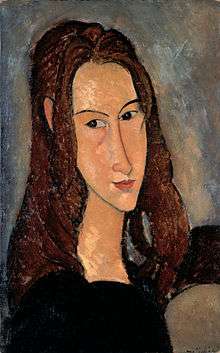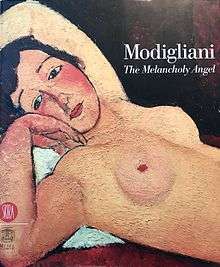Marc Restellini
| Marc Restellini | |
|---|---|
| Born |
24 June 1964 Saint-Omer (France) |
| Nationality | French |
| Occupation |
Art historian Director of museum and Founder of the Pinacothèque de Paris Expert on Amedeo Modigliani |
| Website |
www |
Marc Restellini (born 24 June 1964) is a French art historian, museum director, founder of the Pinacothèque de Paris and a world-renowned expert on Amedeo Modigliani.[1]
Biography
Marc Restellini is a French art historian[2] and museum director. Born in 1964 in Saint-Omer, in Pas-de-Calais, his grandfather was the painter Issac Antcher. Restellini earned a degree in history, then a DEA in art history at the Université Panthéon-Sorbonne, where he later became a lecturer[3] from 1988 to 1993. His thesis at the Sorbonne focused on the painters represented by Leopold Zborowski, the famous art dealer.
He organized his very first exhibition Portraits et paysages chez Zborowski (Portraits and Landscapes of Zborowski)[4] in 1989 at the City Hall of the 6th district in Paris.
In 1992, Marc Restellini organized Tobu Art Museum’s[5] opening exhibition in Tokyo, the first significant exhibition gathering a selection of Modigliani’s masterpieces ever showed in Japan. Through more than 10 years, he perfected a specific system for the roving exhibitions that enabled the production of ambitious projects, while remaining accessible to wide audiences in Asia and Europe. Exhibitions of this nature included the Tobu Museum in Tokyo and in the Municipal Museum in Osaka with productions like Kiki, Reine de Montparnasse (1998), Georges Rouault (1998), From Fra Angelico to Bonnard, The Artpieces of Dr Raw’s private Collection (1999) which then travelled internationally, Sisley (2000) and Redon (2001) just to mention a few.
Parallelly, Marc Restellini curated milestone art exhibitions at an international scale with always making a point of giving a substantial dimension to any retrospective he orchestrated : Zborowski’s painters exhibition inaugurated at the Fondation de l'Hermitage in Lausanne for its 10th Anniversary (1994), Georges Rouault’s (1997) and Modigliani’s retrospectives (1999) at the Modern Art Museum of Lugano in Switzerland, and Picasso’s exhibition at the National Museum of Bogota (2000) inaugurated in the presence of M. Jacques Chirac and the French Ambassy. As the Art Director and Project Manager of the Modern Art Department of the Musée du Luxembourg in Paris from June 2000 to June 2003, Marc Restellini curated outstanding exhibitions such as Raphaël’s retrospective in 2001 and Modigliani’s retrospective in 2002 showcasing 110 art pieces that both hit record numbers of visitors.
Pinacothèque de Paris
In 2003, Marc Restellini decided to launch his own museum, the Pinacothèque de Paris with an exceptional exhibition of Picasso’s artworks, a real masterstroke in the cultural policy and the French Museum landscape[6] acknowledged by the media and praised by the public. This was an unusual institution in Paris, a place where exhibition and dialogue between art forms occurred. Located at Place de la Madeleine, the Pinacothèque de Paris was very soon highly successful[7][8] and in 2010, Restellini opened a second collection.[9]
His solo shows (Soutine and Utrillo-Valadon), his daring themes (Pollock and Shamanism, Giacometti and the Etruscans), as well as his showcasing of unusual pieces (Chinese and Mexican national treasures) ensured, under Restellini’s leadership,[10][11] the ever-growing success of the Pinacothèque de Paris.
As a shrewd cultural entrepreneur, Marc Restellini has always felt that the future of culture would be in Asia. It is indeed based on this vision that he opened a Museum in the historical building of the Fort Canning Arts Centre in Singapour.
His unique curatorial approach is one that adopts the credo of "transversality", a definitive approach which curates contents and creates dialogue that transcends time, cultures, origins and genres ; a conception that allows the exchange and birth of new ideas. This is in line with Marc Restellini’s vision and concept of Museum to trigger a lifescape that encourages creativity amongst people of all ages, cultures, interests and backgrounds, and to expand and deepen the appreciation of arts through everyday engagement.
In 2015, the museum is affected, like the other museums in the capital, by a sharp decline in attendance due to the economic and security context, putting a stop to its development.[12]
Institut Restellini
In addition to his activity as museum director, Marc Restellini develops an institute that implements scientific techniques to support the expertise of the paintings: the Institut Restellini, for scientific and documentary research in art history. By combining scientific methods with the traditional stylistic and historical analysis, the Restellini Institute has in particular vocation the publication of catalogues raisonnés, including Amedeo Modigliani’s Catalogue raisonné.[13]
Marc Restellini is indeed recognized as one of the greatest specialists of the painter Amedeo Modigliani, whom he studied for years.

Amedeo Modigliani
Marc Restellini begins to work on Amedeo Modigliani during his studies. He is at the origin of some of the most important exhibitions dedicated to the artist. Among these, the exhibition at the Musée du Luxembourg, L’Ange au Visage grave in 2002-2003, and Modigliani and Primitivism at the National Art Center in Tokyo in 2008. Eight years later, he is still invited for his expertise on Modigliani at the international level.[14]
Marc Restellini also puts technological and scientific advances at the service of Modigliani's work. In 1997, at the invitation of the art dealer Daniel Wildenstein, he began Amedeo Modigliani’s catalogue raisonné, based on scientific standards unique in the world of research on artworks[15] Modigliani’s catalogue raisonné is based on 600 scientific files and systematic analyses for each work. This scientific rigor makes it possible to establish a comparative calibration. The latter is further refined by the integration of new technologies. For example, Marc Restellini is the first to use a comparative pigment analysis protocol for a paintings catalogue. Other techniques, such as the systematic use of infra-red plates, or digital processes of "fake colors", complete this corpus to achieve a degree of precision of analysis really innovative in this field.[16]
In January 2015, after sixteen years of collaboration, Marc Restellini and the Wildenstein Institute decide to separate. Henceforth, Amedeo Modigliani’s catalogue raisonné is transferred to the Restellini Institute.[17]
Main exhibitions
- 1989: curator of "Portraits and Landscapes at Zborowski’s" exhibition at the Town hall of the 6th arrondissement of Paris. With works of Modigliani, Soutine, Antcher...
- 1991: curator of "Flaure" exhibition at the Musée du Luxembourg.
- 1992: general commissioner of a retrospective dedicated to Modigliani for the Tobu museum in Tokyo (Japan).
- 1993: "Renoir" retrospective for Mainichi press group at the Tobu museum and at the Main Osaka museum. The same year, he is general commissioner of the turning exhibition "Modigliani and his friends" in Japan.
- 1994: exhibition on "The Merchant Zborowski" at the Fondation de l’Hermitage in Lausanne (Switzerland) and at the Palazzo Vecchio in Florence (Italy).
- 1997: "Georges Rouault" retrospective at the Museum of Modern Art of Lugano (Switzerland).
- 1998: In charge of the exhibition for the centenary of "Eugène Boudin" at the National Museum of Colombia in Bogotá.
- 1999: Traveling exhibition of the "Masterpieces from Dr. Rau's collection" in Japan, in the USA and in Europe.
- 2002-2003: "Modigliani, The Melancholy Angel", at the Musée du Luxembourg in Paris and later at the Palazzo Reale in Milan (Italy).
- 2003-2016 : all the exhibitions of the Pinacothèque de Paris among which:
- Picasso Intime
- The Xi'an warriors: "Soldiers of Eternity"
- Georges Rouault: Masterpieces from the Idemitsu collection
- Jackson Pollock and Shamanism: A New Interpretation
- The Dutch Golden Age - From Rembrandt to Vermeer
- Edvard Munch or the "Anti-Scream"
- The Incas gold: Origins and Mysteries
- Giacometti and the Etruscans
- The Netter Collection: Modigliani, Soutine and the Montparnasse Adventure
- Van Gogh: Dreams of Japan - Hiroshige: the Art of Travel
- Chu Teh-Chun: Ways to Abstraction
- In the Time of Klimt, the Vienna Secession
- Pressionism: the Masterpieces of Graffiti on Canvas - from Basquiat to Bando
- 2017 : Curator of the exhibition Modigliani, Soutine and other legends of Montparnasse at Fabergé Museum in Saint-Petersburg (Russia).
Publications

- "Modigliani, ses mécènes, ses marchands, ses collectionneurs", in the Catalogue de l’exposition Modigliani au Japon, 1992–93, p. 46-51
- "Zborowski, merchant and poet", in L’Œil, July–August 1994, p. 52-59
- "Zborowski, le marchand-poète", p. 9-16 et « La carrière d’un nouvel artiste dans un nouveau monde de l’art (de Paul Alexandre à Léopold Zborowski) », in the exhibition catalogue "Zborowski's painters, Modigliani, Utrillo, Soutine and their friends", Lausanne, Fondation de l’Hermitage, 24 June-23 October 1994, p. 21-32
- « Zborowski, il mercante-poeta », p. 19-26 and « La carriera di un nuovo artista in un nuovo mondo dell’arte, da Paul Alexandre a Léopold Zborowski », in the exhibition catalogue "Modigliani, Soutine, Utrillo e i pittori di Zborowski", Florence, Palazzo Vecchio, 19 November 1994 – 5 March 1995, p. 31-41
- "Il clima artistico di Parigi tra il 1910 e il 1925. Modigliani nel cuore degli anni folli", in the exhibition catalogue "Amedeo Modigliani", Lugano (Switzerland), 28 March-27 June 1999, p. 55-86
- "Modigliani, "l'Ange au Visage grave": Resurrecting the Œuvre and Questions of Authenticity" p. 11-16, "Modigliani: Avant-Garde Artist or "Schizophrenic Painter"?" p.17-32, "Paul Alexandre and the Delta Adventure" p. 94-100, "Modigliani and Paul Guillaume" p. 167-172, and "The Unusual Case of Léopold Zborowski" p. 273-282, in the exhibition catalogue "Modigliani, the Melancholy Angel", Paris, Musée du Luxembourg-Skira, 23 October 2002 – 2 March 2003
- Francis Berthier et Marc Restellini, "The Great Collectors of Modigliani in 1920", in the exhibition catalogue "Modigliani, the Melancholy Angel", Paris, Musée du Luxembourg-Skira, 23 October 2002 – 2 March 2003, p. 409-416
- Le Silence éternel : Modigliani - Hébuterne 1916-1919", including the Catalogue Raisonné of painting and drawings of Jeanne Hébuterne, Pinacothèque de Paris, 2008
- Marc Restellini, "Modigliani, Soutine e gli artisti maledetti - La Collezione Netter", 2013, 24 Ore Cultura editore, ISBN 978-8866481850 - Catalogo della mostra
Notes and references
- ↑ Gautheret, Jérôme (2017-06-13). "A Gênes, soupçons de faux sur l'exposition Modigliani". Le Monde.fr (in French). ISSN 1950-6244. Retrieved 2017-06-16.
- ↑ Apartia. "CritikArt.Net - fiche de Marc Restellini". www.critikart.net (in French). Retrieved 2017-04-26.
- ↑ "Dossier. Marc Restellini, le trublion de l'art. Dossier. Marc Restellini, le trublion de l'art". La Croix (in French). 2010-02-25. ISSN 0242-6056. Retrieved 2017-04-26.
- ↑ "Carrefour Vavin. Paris - Organisation - Resources from the BnF". data.bnf.fr. Retrieved 2017-04-26.
- ↑ "Marc Restellini: quand l'Histoire de l'Art se raconte - Culture Minute". Culture Minute (in French). 2016-11-15. Retrieved 2017-04-26.
- ↑ BUSINESS, BFM, Le Paris de Marc Restellini, Pinacothèque de Paris - 09/06 (in French), BFM BUSINESS, retrieved 2017-04-26
- ↑ "La Revue de Presse - Accueil | Marc Restellini". Marc Restellini (in French). Retrieved 2017-04-26.
- ↑ magazine, Le Point,. "Archives - Le Point.fr". Le Point.fr (in French). Retrieved 2017-04-26.
- ↑ "Pinacothèque de Paris : Naissance d'un musée". Tout Pour Les Femmes (in French). 2011-01-20. Retrieved 2017-04-26.
- ↑ "Marc Restellini, l'art et la manière". magazine-decideurs.com (in French). Retrieved 2017-04-26.
- ↑ "Marc Restellini, le musée autrement". L'Opinion (in French). 2014-11-04. Retrieved 2017-04-26.
- ↑ "Pourquoi la fréquentation des musées baisse". La Croix (in French). 2016-01-12. ISSN 0242-6056. Retrieved 2017-04-26.
- ↑ "Modigliani Expert Promises New Catalogue Raisonné | artnet News". artnet News. 2016-07-22. Retrieved 2017-04-26.
- ↑ "El historiador francés Marc Restellini hablará sobre Modigliani en el Museo San Carlos - Proceso". Proceso (in Spanish). 2016-10-29. Retrieved 2017-04-26.
- ↑ "Home - Institut Restellini". www.institut-restellini.com. Retrieved 2017-04-26.
- ↑ "The Institute - Institut Restellini". www.institut-restellini.com. Retrieved 2017-04-26.
- ↑ "Catalogues raisonnés - Institut Restellini". www.institut-restellini.com. Retrieved 2017-04-26.